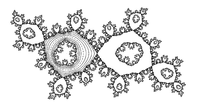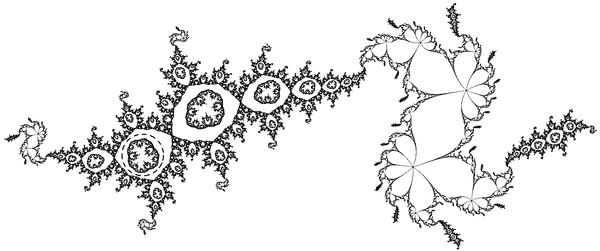Herman ring

In the mathematical discipline known as complex dynamics, the Herman ring is a Fatou component.[1] where the rational function is conformally conjugate to an irrational rotation of the standard annulus.
Formal definition
Namely if ƒ possesses a Herman ring U with period p, then there exists a conformal mapping
and an irrational number  , such that
, such that
So the dynamics on the Herman ring is simple.
Name
It was introduced by, and later named after, Michael Herman (1979) who first found and constructed this type of Fatou component.
Examples
Here is an example of a rational function which possesses a Herman ring.[1]
where  such that the rotation number of ƒ on the
unit circle is
such that the rotation number of ƒ on the
unit circle is  .
.
The picture shown on the right is the Julia set of ƒ: the curves in the white annulus are the orbits of some points under the iterations of ƒ while the dashed line denotes the unit circle.
There is an example of rational function that possesses a Herman ring, and some periodic parabolic Fatou components at the same time.

 that possesses a Herman ring and some periodic parabolic Fatou components, where
that possesses a Herman ring and some periodic parabolic Fatou components, where  such that the rotation number of
such that the rotation number of  on the unit circle is
on the unit circle is  . The image has been rotated.
. The image has been rotated.Further, there is a rational function which possesses a Herman ring with period 2.

Here the expression of this rational function is
where
This example was constructed by quasiconformal surgery[2] from the quadratic polynomial
which possesses a Siegel disk with period 2. The parameters a, b, c are calculated by trial and error.
Letting
then the period of one of the Herman ring of ga,b,c is 3.
Shishikura also given an example:[3] a rational function which possesses a Herman ring with period 2, but the parameters showed above are different from his.
So there is a question: How to find the formulas of the rational functions which possess Herman rings with higher period?
According to the result of Shishikura, if a rational function ƒ possesses a Herman ring, then the degree of ƒ is at least 3. There also exist meromorphic functions that possess Herman rings.
References
- ↑ 1.0 1.1 John Milnor, Dynamics in one complex variable: Third Edition, Annals of Mathematics Studies, 160, Princeton Univ. Press, Princeton, NJ, 2006.
- ↑ Mitsuhiro Shishikura, On the quasiconformal surgery of rational functions. Ann. Sci. Ecole Norm. Sup. (4) 20 (1987), no. 1, 1–29.
- ↑ Mitsuhiro Shishikura, Surgery of complex analytic dynamical systems, in "Dynamical Systems and Nonlinear Oscillations", Ed. by Giko Ikegami, World Scientic Advanced Series in Dynamical Systems, 1, World Scientic, 1986, 93–105.
- Herman, Michael-Robert (1979), "Sur la conjugaison différentiable des difféomorphismes du cercle à des rotations", Publications Mathématiques de l'IHÉS (49): 5–233, ISSN 1618-1913, MR 538680






